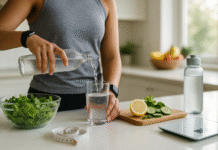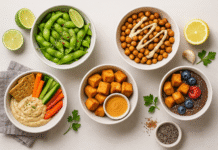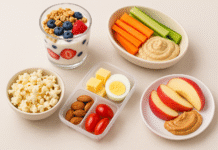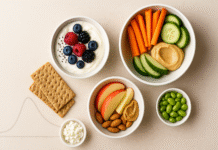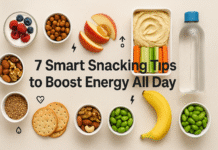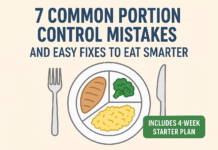Portion control is the simplest, most powerful habit you can add to your daily routine to stop overeating, balance calories, and feel better after meals. In this article you’ll learn ten practical, easy-to-follow strategies you can use at breakfast, lunch, dinner, and snacks — plus a ready-to-run 4-week starter plan, troubleshooting tips, ways to measure progress, and 10+ FAQs. This guide is for busy adults, parents, and anyone who wants sustainable portion control without becoming a short-order chef or counting every calorie.
Medical disclaimer: this article offers general nutrition and habit tips only. If you have a medical condition, are pregnant, nursing, or taking medication that affects appetite or weight, consult a qualified healthcare professional or registered dietitian for personalized guidance.
Key takeaways
- Small, consistent changes beat extreme rules. Tiny shifts in plate size, composition, and timing produce big results over weeks.
- Use visual guides and simple tools (plate method, hand measures, smaller plates) rather than obsessive weighing.
- Combine portion control with food choices (more vegetables, lean protein, lower energy-density foods) for the biggest impact.
- Measure progress by behavior and trends, not daily weight swings.
- Plan, practice, and troubleshoot — build a 4-week routine that becomes second nature.
How this article is organized
Because the title is a list, each of the ten main H2 sections covers one specific portion-control strategy. For every strategy you’ll get: what it is and why it helps; what you need or low-cost alternatives; step-by-step implementation; beginner modifications and ways to scale; how often to use it; safety and common mistakes; and a tiny, practical 2–3 step mini-plan you can try immediately.
Where I make evidence-based factual claims (for example, about how larger portions change intake), I’ve included supporting references at the end of the article so you can read further.
1. Use the Plate Method: Fill half with plants
What it is and core benefits
The plate method is a visual rule: make vegetables and fruit half your plate, a quarter grains or starchy foods, and a quarter protein. Its purpose is to automatically increase fiber and volume while reducing calorie-dense components, which helps control calorie intake and improve meal satisfaction.
Requirements / low-cost alternatives
- Need: any dinner plate and a willingness to rearrange foods.
- Low-cost alternative: use a bowl and mentally divide it into halves/quarters, or draw lines on a reusable plate divider.
Step-by-step implementation
- When serving, place vegetables/fruit to occupy half the plate first.
- Add a moderate palm-sized portion of protein (1 palm = roughly 3–4 oz cooked for many adults).
- Finish with a quarter plate of whole grains or starchy vegetable.
Beginner modifications and progressions
- Start by making vegetables just one-third of the plate, then increase to half over two weeks.
- Progress by experimenting with more non-starchy vegetables (leafy greens, roasted mixed veggies) to increase volume further.
Recommended frequency / duration / metrics
- Use at least one meal per day to build the habit, then extend to all main meals.
- Metric: number of meals per week where half the plate is vegetables (goal: 14/14 for two meals/day by week 4).
Safety, caveats, common mistakes
- Caveat: athletes or people with higher energy needs may need larger grain/protein portions. Adjust portion sizes to match activity.
- Mistake: piling starchy sides on top of vegetables — keep visual separation to avoid underestimating starchy portions.
Sample mini-plan (2 steps)
- Tonight: fill half your plate with salad or mixed roasted veggies.
- Tomorrow lunch: repeat and note whether you felt satisfied 2 hours later.
Evidence note: visual plate-based tools are widely used as practical guides to balance meals and reduce energy-dense portions.
2. Downsize dinnerware and serving utensils
What it is and core benefits
Using smaller plates, bowls, and spoons makes portions look larger and reduces the amount you serve. This simple perceptual trick reduces automatic overeating without conscious hunger suppression.
Requirements / low-cost alternatives
- Need: smaller plates (7–9 inch salad plates) and smaller bowls/utensils.
- Low-cost alternative: use a salad plate or bread plate for main meals; serve on a smaller plate and hide larger plates.
Step-by-step implementation
- Replace one regular dinner plate with a smaller plate for all meals for one week.
- Use smaller serving spoons and avoid family-style reloading.
- If serving buffet-style, put serving dishes further away so you take less with each pass.
Beginner modifications and progressions
- Start with one meal per day on smaller dinnerware. Progress to all main meals.
- If dining out, consciously order an appetizer or share an entrée to mimic smaller plate portions.
Recommended frequency / duration / metrics
- Use smaller plates consistently at home.
- Metric: average portion reduction as perceived (simple self-rating 1–5); aim for consistent two-point reduction in perceived fullness right after meals.
Safety, caveats, common mistakes
- Mistake: piling a small plate high with calorie-dense foods; smaller dinnerware works best when combined with better food choices.
- Caveat: don’t underfuel if you have higher calorie needs; simply use the plate method with nutrient-dense foods.
Sample mini-plan (2 steps)
- Swap in a salad plate for dinner tonight.
- Notice portion size and hunger two hours after the meal.
Evidence note: changing plate size consistently alters portion selection and intake.
3. Learn quick “hand” portion guides for on-the-go measuring
What it is and core benefits
Hand-based measures use your own palm, fist, thumb, and cupped hand as quick, no-tools portion guides. They’re portable, personal, and correlate surprisingly well with recommended portion ranges for adults.
Requirements / low-cost alternatives
- Need: none — your hand is the tool.
- Low-cost alternative: keep a small card or note in your wallet with the hand-portion rules until memorized.
Step-by-step implementation
- Palm = protein portion (a cooked palm-sized piece per meal).
- Fist = one cup (use for vegetables, fruit, or cooked grains).
- Cupped hand = ½ cup (use for snacks, rice, pasta).
- Thumb = tablespoon measure for fats like oil, nut butters.
Beginner modifications and progressions
- Start by using the hand guide for protein and carbs only; after two weeks add vegetable portion checks.
- Progress by adjusting for your hand size and activity level (larger or more active people may need larger palm portions).
Recommended frequency / duration / metrics
- Use every meal away from home or when you don’t want to measure.
- Metric: percentage of meals per week using hand-guides (goal: 80% by week 3).
Safety, caveats, common mistakes
- Mistake: confusing raw and cooked volume (meat shrinks when cooked).
- Caveat: hand sizes vary — use the method as a flexible rule, not an exact science.
Sample mini-plan (2 steps)
- Today: use the palm rule for your protein at lunch.
- This week: use a cupped hand to measure snacks.
Evidence note: hand guides are commonly recommended as simple tools for portion estimation and are used in public health materials. British Nutrition Foundation
4. Plate and serve food in the kitchen (not at the table)
What it is and core benefits
Serving meals in the kitchen — portioning once and sitting down — reduces second helpings and mindless refills. Out of sight, out of mind: clearing serving dishes decreases impulsive top-ups.
Requirements / low-cost alternatives
- Need: serving bowls and single-plate plating.
- Low-cost alternative: use a large cutting board or baking tray to assemble plates then bring them to the table.
Step-by-step implementation
- When the food is ready, serve each person’s portions in the kitchen.
- Put back serving dishes in the fridge or counter out of reach.
- If someone wants seconds, wait 10 minutes and re-evaluate hunger first.
Beginner modifications and progressions
- Start by serving one main meal this way. Advance to all family meals.
- For family-style kids, offer small second-helpings only after 10–15 minutes and only if still hungry.
Recommended frequency / duration / metrics
- Aim to serve in the kitchen for all evening meals.
- Metric: number of meals per week without second helpings (target: decrease second helpings by 50% in 2 weeks).
Safety, caveats, common mistakes
- Mistake: serving too conservatively and leaving people still hungry consistently. Offer a small, healthy after-meal snack if needed.
- Caveat: social meals and buffets may be exceptions — pre-portion when possible.
Sample mini-plan (2 steps)
- Tonight: plate everyone’s dinner in the kitchen.
- If someone asks for seconds, wait 10 minutes and offer fruit instead.
5. Pre-portion snacks and keep trigger foods out of reach
What it is and core benefits
Pre-portioning snacks into single-serve bags, containers, or plates stops you from eating straight from a large package — a common route to overeating. Keeping high temptation foods out of sight reduces automatic nibbling.
Requirements / low-cost alternatives
- Need: reusable containers, zip bags, or small snack bowls.
- Low-cost alternative: use paper cups, cut small squares of wax paper, or repurpose jam jars.
Step-by-step implementation
- When you bring groceries home, divide snacks (nuts, chips, crackers) into single-serve portions.
- Label portions with date and contents if helpful.
- Store bulk packages out of immediate reach — in a cupboard or upper shelf.
Beginner modifications and progressions
- Start by pre-portioning only one favorite snack you overeat. Progress to all snacks.
- Next level: include portioned fruit+protein snacks for better satiety.
Recommended frequency / duration / metrics
- Pre-portion weekly when you unpack groceries.
- Metric: number of unplanned snack portions eaten per week (goal: reduce by 50% over two weeks).
Safety, caveats, common mistakes
- Mistake: pre-portioning unhealthy snacks and then eating several portions because they’re prepped and handy — still practice restraint.
- Caveat: sodium and fat-dense snacks are easy to overconsume; pair with water or a piece of fruit for satiety.
Sample mini-plan (2 steps)
- Today: portion out a week’s worth of nuts into 1-ounce portions.
- Put the big bag on a high shelf.
6. Choose lower-energy-density foods first
What it is and core benefits
Energy density = calories per gram. Foods like vegetables, broth-based soups, and fruit are low energy density and allow large, filling portions for fewer calories. Swapping energy-dense starters for low-density options reduces total meal calories while keeping you satisfied.
Requirements / low-cost alternatives
- Need: access to vegetables, broth, and produce.
- Low-cost alternative: frozen vegetables and canned beans are inexpensive low-density staples.
Step-by-step implementation
- Start the meal with a large salad, broth-based soup, or a vegetable side.
- Wait 5 minutes before serving calorie-dense main dishes; often you’ll eat less.
- Fill half your plate with low-density foods (see Plate Method).
Beginner modifications and progressions
- Start by adding only a small side salad; progress to replacing half a starchy side with steamed veggies.
- Experiment with vegetable-heavy recipes you enjoy (stir-fries, stews, large salads).
Recommended frequency / duration / metrics
- Use this at every main meal.
- Metric: percent of plate volume from low-density foods (goal: ≥50% by week 3).
Safety, caveats, common mistakes
- Mistake: thinking “low-energy-density” means low-nutrient; choose whole veggies rather than sugary, low-fat processed options.
- Caveat: adding lots of oil, cheese, or creamy dressings raises energy density — use dressings sparingly or on the side.
Sample mini-plan (2 steps)
- Tonight: start with a 2-cup vegetable soup or salad before the main course.
- Note how much of the main dish you eat afterwards.
Evidence note: reducing portion size and lowering energy density both independently lower calorie intake; combining them has additive effects.
7. Measure and visualize portions for the first two weeks
What it is and core benefits
Spend 1–2 weeks measuring portions with a food scale or measuring cups to recalibrate what “one serving” looks like. Often people’s mental models of serving sizes are far larger than recommended; accurate measuring speeds learning and builds correct portion sense.
Requirements / low-cost alternatives
- Need: a small kitchen scale or measuring cups.
- Low-cost alternative: many smartphone apps show portion volumes, or you can use household items (cup, mug) as rough measures.
Step-by-step implementation
- For 14 days, measure one portion of common foods (rice, pasta, cereal, protein, oil) and transfer to a plate.
- Take a photo of measured portions to build a visual library.
- After two weeks, use photos to eyeball portions without measuring.
Beginner modifications and progressions
- If a scale feels intimidating, measure only your most over-consumed items first (cereal, snacks).
- Progress by using measured photos to serve without the scale.
Recommended frequency / duration / metrics
- Measure daily for 14 days. After that, measure once weekly to check accuracy.
- Metric: number of times you eyeball correctly in a week (self-check with photo library; target: 4/7).
Safety, caveats, common mistakes
- Mistake: measuring only once and assuming the rest of the week will match — habits need repetition.
- Caveat: measuring all foods forever is unnecessary — the goal is to internalize correct portions.
Sample mini-plan (2 steps)
- Buy or borrow a small scale and measure a single serving of cooked rice, chicken, and oil tonight.
- Save photos in a folder labeled “portion guide.”
8. Slow down: practice mindful bites and timing
What it is and core benefits
Eating slower gives your brain time to register fullness, which typically arrives 15–20 minutes into a meal. Slowing down reduces overeating and increases meal satisfaction.
Requirements / low-cost alternatives
- Need: none. Practice only requires attention.
- Low-cost alternative: set a timer for 20 minutes for the first week to remind you to slow down.
Step-by-step implementation
- Put your fork down between bites. Chew each bite 20–30 times if you can.
- Pause halfway through your plate and assess hunger.
- Aim for a 20-minute meal pace.
Beginner modifications and progressions
- Begin by pausing once during your meal. Progress to a consistent fork-down habit between bites.
- Use a small glass of water between mouthfuls to naturally slow pace.
Recommended frequency / duration / metrics
- Practice at least one meal per day for the first two weeks.
- Metric: average meal duration in minutes (goal: increase by 5–10 minutes over baseline).
Safety, caveats, common mistakes
- Mistake: substituting distraction (phone, TV) with eating faster — remove screens to support mindful eating.
- Caveat: social meals may be quicker; still practice awareness and pauses.
Sample mini-plan (2 steps)
- Tonight: set a silent phone alarm for 20 minutes and aim to finish dinner by then.
- Pause halfway and reflect: are you still hungry?
9. Portion-control when eating out: split, pre-order, or box half
What it is and core benefits
Restaurant portions are frequently larger than standard single-meal portions. Simple tactics — splitting an entrée, boxing half immediately, or ordering starters instead of mains — keep calories sensible while letting you enjoy dining out.
Requirements / low-cost alternatives
- Need: willingness to request modifications or box food early.
- Low-cost alternative: order side salads instead of fries; ask for sauces on the side.
Step-by-step implementation
- Before the meal arrives decide: split, box, or choose a smaller menu item.
- When food arrives, immediately box half or share plates.
- If splitting isn’t an option, choose two appetizers rather than an entrée and one side.
Beginner modifications and progressions
- Start by boxing half of a restaurant entrée once per week. Progress to using this approach any time you’re unsure of portions.
Recommended frequency / duration / metrics
- Use at every restaurant meal until you have a reliable sense of restaurant serving sizes.
- Metric: number of restaurant meals where you boxed or split (goal: 100% within 6 weeks).
Safety, caveats, common mistakes
- Mistake: thinking “splitting dessert” means you can eat both halves — still portion consciously.
- Caveat: special celebrations may be exceptions; plan and enjoy without guilt.
Sample mini-plan (2 steps)
- This weekend, if you go out, order a main to share or box half as soon as it’s served.
- Note your fullness 2 hours after the meal.
10. Keep a simple, repeatable routine: plan, prep, and reflect
What it is and core benefits
Portion control succeeds when it’s a system, not a single trick. Planning meals, prepping portions, and reflecting briefly each day keeps you accountable and reduces decision fatigue.
Requirements / low-cost alternatives
- Need: a weekly planning habit (15–30 minutes).
- Low-cost alternative: use a simple paper checklist or phone notes to plan meals.
Step-by-step implementation
- Each Sunday, plan the week’s dinners and note suggested portions.
- Batch-cook components (grains, roasted veggies, grilled protein) and store in portioned containers.
- Each evening, reflect on what went well and what you’ll tweak.
Beginner modifications and progressions
- Start with planning only five dinners per week. Progress to breakfast and lunch planning as the habit strengthens.
Recommended frequency / duration / metrics
- Weekly planning session; daily 1–2 minute reflection.
- Metric: number of planned meals executed per week (target: 5/7 consistent plans followed).
Safety, caveats, common mistakes
- Mistake: rigid plans without flexibility — plan 1–2 “swap” meals for unexpected events.
- Caveat: some days will fall apart — treat them as data, not failure.
Sample mini-plan (2 steps)
- Sunday: plan three dinners and portion components into reusable containers.
- Each night: check off whether portions matched the plan.
Quick-start checklist (warm-up you can do in 15 minutes)
- Swap one dinner plate for a smaller plate today.
- Pre-portion one snack item (e.g., nuts) into 5 single-serve bags.
- Tonight, fill half your plate with vegetables.
- Take a photo of one measured portion for your visual library.
- Set a timer to eat one meal for at least 15 minutes.
Troubleshooting and common pitfalls
Problem: I try to control portions but still feel hungry after meals.
Solution: Add lean protein and fiber to meals (beans, fish, chicken, legumes, whole grains). Use the plate method to ensure vegetables make up half your plate; this increases volume and satiety without many calories. Also check that you’re not drinking excessive calories (sugary drinks).
Problem: I keep finishing my kids’ plates or others’ leftovers.
Solution: Serve portions separately and put serving dishes away. Model the plate method for children and allow second helpings only after a pause and hunger check.
Problem: Measuring every meal is tedious.
Solution: Measure for two weeks to build visual memory, then rely on hand guides and plate method. Use weekly spot checks.
Problem: Social events and holidays derail me.
Solution: Apply “portion-first” tactics: take smaller portions, eat mindfully, and choose one or two special items to enjoy rather than all foods.
How to measure progress (practical metrics that matter)
Avoid daily weight obsession. Instead track behaviors and trends:
- Behavior KPIs (weekly): number of meals using plate method, number of pre-portioned snacks used, number of meals served from the kitchen (not family-style).
- Satisfaction measures: after-meal fullness rated 1–5 without guilt.
- Trend metrics (monthly): average weekly weight (if relevant), waist measurement every 2 weeks, energy levels, clothing fit.
- Adherence metric: percent of meals in the week where you followed at least one portion-control tactic (goal: increase by 10% each week).
Simple 4-week starter plan (easy roadmap)
Week 1 — foundation
- Swap to smaller plates for dinner every day.
- Use the plate method at one meal daily.
- Pre-portion one snack item.
Week 2 — add skills
- Measure and photograph one serving of staples (rice, pasta, cereal) three times this week.
- Practice hand-portion guides for proteins and carbs at lunches.
- Slow down one meal per day (fork down between bites).
Week 3 — consistency & out-of-home strategies
- Serve all dinners in the kitchen.
- When eating out, box half immediately or split your entrée.
- Continue pre-portioning snacks for the week.
Week 4 — automation & reflection
- Plan and prep three meals on Sunday (batch cook).
- Track behavior KPIs daily and reflect each evening for 2 minutes.
- Evaluate progress: Which tactics stuck? Which need tweaking?
Frequently Asked Questions (8–12)
1. Is portion control the same as calorie counting?
No. Portion control focuses on the amount and composition of what you eat to naturally reduce intake. Calorie counting is precise and useful for some people, but portion control is simpler and more sustainable for most.
2. Will portion control make me feel deprived?
Not if you shift volume toward low-energy-density foods (vegetables, soups, fruit) and include protein. The goal is satisfaction, not deprivation.
3. How quickly will I see results?
Behavioral changes can be felt immediately in terms of fullness and energy. For weight or waist changes, expect measurable differences in 2–6 weeks depending on consistency.
4. Can portion control help with cravings?
Yes. Structured meals and pre-portioned snacks reduce impulsive eating and help retrain hunger cues over time.
5. I cook for a family — how do I portion for different needs?
Use the plate method as a template, but adjust the quarter portions up or down for children, athletes, or those with higher calorie needs. Let kids decide when they’re done to support internal hunger cues.
6. Do I need a food scale forever?
No. Measuring temporarily (1–2 weeks) helps recalibrate your eyes. After that, hand guides and plate visuals usually suffice.
7. What about alcohol and portion control?
Alcoholic drinks can add significant calories. Pour smaller servings, alternate with water, and avoid sugary cocktails when portion control is your goal.
8. Are there medical situations where portion control is unsafe?
If you have a history of an eating disorder, unstable blood sugar, or a medical condition that requires specific intake levels, consult a clinician before changing meal patterns.
9. How do I handle holiday meals or special events?
Plan ahead: choose one or two items to enjoy, use the plate method for the rest, and allow yourself a mindful portion of favorites.
10. Should I weigh food to get it right?
Weighing can be helpful during the learning phase. Once you internalize portions, eyeballing with hand guides works for most people.
11. What’s the difference between serving size and portion size?
A serving size is a recommended amount (often used on labels); a portion is what you actually choose to eat. Portion control helps align portions closer to recommended serving sizes.
12. How do I stay consistent when busy or stressed?
Automate: pre-portion snacks, batch-cook staples, keep healthy low-density options ready. When stressed, slow down and use the hand-guides to avoid defaulting to oversized servings.
Final thoughts and motivation
Portion control isn’t a one-off rule; it’s a set of friendly habits that stack together. Start small — swap one plate, pre-portion one snack, or add an extra serving of vegetables — and build momentum. Over weeks, those tiny choices become your new normal, and you’ll eat less without constant willpower battles.
Take action now: pick one of the ten tactics above and try it at your next meal.
References
- Potential moderators of the portion size effect — International Journal of Behavioral Nutrition and Physical Activity (PMC article), 2019. https://pmc.ncbi.nlm.nih.gov/articles/PMC6483383/
- Sizing up the Effect of Portion Size on Consumption: A Meta-Analytic Review — Journal of Marketing Research (meta-analysis), 2012. https://journals.sagepub.com/doi/10.1509/jm.12.0303
- Reductions in portion size and energy density of foods are associated with decreases in energy intake — American Journal of Clinical Nutrition (PubMed), 2006. https://pubmed.ncbi.nlm.nih.gov/16400043/
- Healthy Eating Plate — Harvard T.H. Chan School of Public Health, Nutrition Source (Healthy Eating Plate guide), 2012 (page updated). https://nutritionsource.hsph.harvard.edu/healthy-eating-plate/
- What Is MyPlate? — U.S. Department of Agriculture (MyPlate guide and messages). https://www.myplate.gov/eat-healthy/what-is-myplate
- The Eatwell Guide — National Health Service (NHS) UK (balanced plate guide). https://www.nhs.uk/live-well/eat-well/food-guidelines-and-food-labels/the-eatwell-guide/
- Hand portion guide (A4 Document) — Leicestershire Partnership NHS (hand portion guide PDF). https://www.leicspart.nhs.uk/wp-content/uploads/2022/03/Hand-portion-guide-A4-Document-1-1.pdf
- Portion sizes: everything you need to know — British Heart Foundation (practical plate and portion advice). https://www.bhf.org.uk/informationsupport/heart-matters-magazine/nutrition/weight/perfect-portions/portion-sizes





























